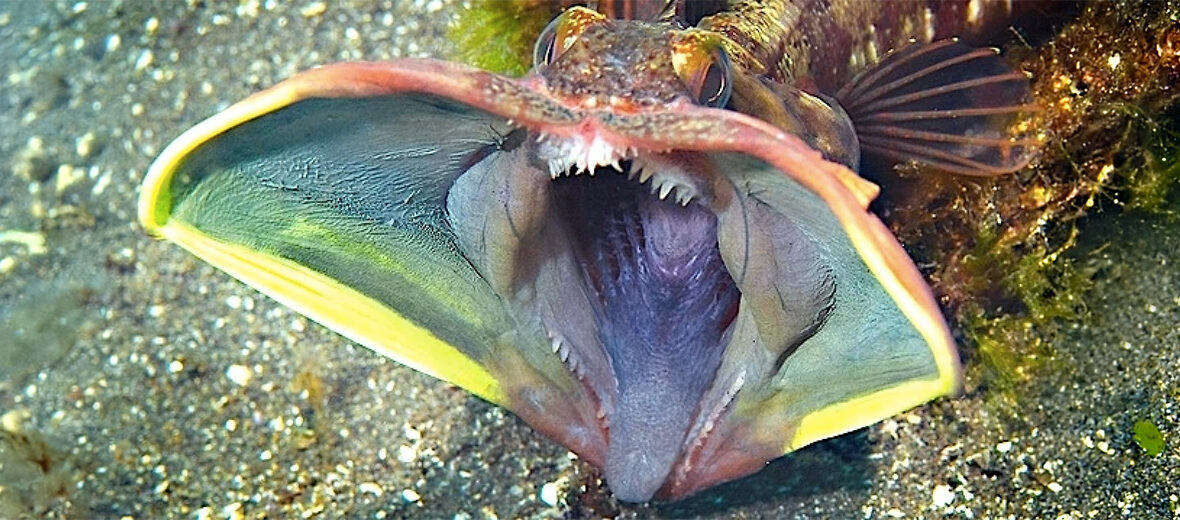
The sarcastic fringehead is named for their large mouth and aggressive demeanor. The name fringehead was given due to the ruff of tissue surrounding their neck. These fish can be found from San Fransisco, California down to the Baja California coastline at depths of 9.84 – 239.5 feet. With no major threats to their survival sans pollution, these blennies are listed as Least Concern by the IUCN. Their population trend is listed as unknown.
First the Stats…
Scientific name: Neoclinus blanchardi
Weight: Up to 5 ounces
Length: Up to 12 inches
Lifespan: Up to 6 years
Now on to the Facts!
1.) Their specific name honors Dr. S. B. Blanchard of San Diego, California, who collected specimens of this blenny and delivered them to Charles Frédéric Girard, who then described them.
2.) They gape (open their mouth widely) to display prowess.
3.) Long-jawed mudsuckers a similar species, also displays this gaping behavior and elongated maxillae, indicating convergent evolution related to the defense of their burrow.
4.) There are 3 known species of fringeheads: sarcastic, onespot, and yellowfin. Sarcastic fringeheads are the most aggressive of the 3 species.
5.) These fish dwell along sandy and muddy sea bottoms below the low tide line. They typically back into objects and cavities, like shells, burrows, and other crevices, exposing only their heads.
But wait, there’s more on the sarcastic fringehead!
6.) When 2 fringeheads have a territorial standoff, they wrestle by pressing their distended mouths against one another, in a kissing fashion. They continue to press against each other until 1 is able to bite the other’s head. This provides them the ability to determine which is the bigger fish, which then establishes dominance.
7.) This male vs male competition is enacted to secure shelter, which is crucial to their survival in a dangerous environment.
Did you know…?
When opened, their mouth can be as great as 4x as large as when it’s closed.
8.) The loser of the battle must then search for a new place to live, which expends energy that would otherwise be spent looking for food or a mate.
9.) The evolution of their aggressive display is a prime example of heterochrony. This is where changes in the timing and rate of development have resulted in enhanced features that amplify their territorial and mating behaviors.
10.) Females spawn up to 3,000 eggs and places them under rocks, large shells, or trash.
But wait, there’s still more on the sarcastic fringehead!
11.) The male will guard and fan the eggs until they hatch.
12.) Besides consuming large amounts of squid eggs, they primarily feed on crustaceans and zooplankton.
13.) Being ram-suction feeders, they rely on fast movements and the ability to literally suck prey items into their mouth.
14.) Divers have noted that these aggressive fish are capable of damaging their wetsuits when biting the perceived intruders (those intruders being the divers) with their needle sharp teeth.
Now a Short Sarcastic Fringehead Video!
Be sure to share & comment below! Also, check out the Critter Science YouTube channel. Videos added regularly!
Want to suggest a critter for me to write about? Let me know here.
Some source material acquired from: Wikipedia & IUCN
Photo credit: Animals.Fandom.com




